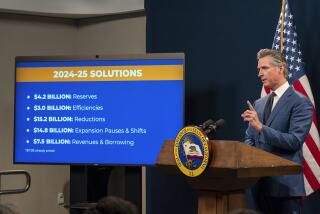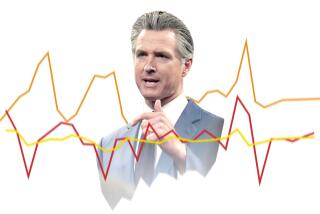Curing pension envy
California doesn’t have just one pension crisis, it has two.
In the public realm, generous pensions and retiree health benefits have triggered a crisis as elected leaders try to square expensive promises with the realities of diminished revenues and investment losses. In California, commitments to retired state workers are crowding out crucial investments in education, health and infrastructure.
In the private realm, it’s a lack of pensions that is the problem. The same investment losses that diminished public pension funds have also drained 401(k) plan balances and highlighted the vulnerability of the do-it-yourself retirement systems that have largely replaced defined-benefit pensions in the private sector. For large numbers of middle-age Californians, shrunken retirement accounts and “underwater” home mortgages have made retirement security a fading dream.
Understandably, this combination of public affluence and private squalor has touched off pension envy, with calls for the state to abandon its gold-plated retirement system. But the right answer for California is not to tear down but to build up. We must create a fiscally sustainable pension system that offers adequate retirement security to public and private workers alike.
One response to the public pension crisis has been a call to move all public employees to 401(k) plans. Leaving public workers to bear all the investment risks of retirement saving, as most private workers now do, might reduce pension envy. But the do-it-yourself retirement system of 401(k) plans has left 51% of workers facing retirements in which they will be unable to maintain current lifestyles, according to the Center for Retirement Research at Boston College. This is a step away from what should be California’s goal: retirement security for its residents.
Another reform approach, pushed by Gov. Arnold Schwarzenegger, would retain traditional pensions for existing public employees while creating a lower tier of benefits for new workers. The problem is, California already tried this. State and some local governments put in place two-tier benefit systems during the long economic downturn of the 1990s.
That experiment taught two lessons. First, by its nature, a two-tier system provides little short- to medium-term relief for public budgets, particularly in an environment in which governments are hiring few new workers.
More important, long-term savings are equally elusive. A two-tier system is inherently unstable. Setting different levels of pension compensation for people doing identical jobs injects pension envy into the workplace and creates immediate pressure to equalize benefits. California’s last experiment with two tiers was quickly undone when SB 400 in 1999 made the lower tier optional and allowed workers to buy their way into the higher tier at bargain rates.
There is, however, another long-term reform option for California, one that would provide more retirement security for public workers and more fiscal stability and certainty for taxpayers. It is known as a cash balance pension, a hybrid that combines the best aspects of defined-benefit or pension-style plans and defined-contribution plans such as 401(k)s. Many private employers are moving to cash balance plans because they offer more flexibility and less risk. The state of Nebraska embraced them after determining that its employees’ defined-contribution plans performed so poorly that contributing to them was a waste of taxpayer resources.
A cash balance plan has two pieces. As in a 401(k), an employer contributes a percentage of a worker’s salary into an account that belongs to the worker. But unlike a 401(k), the employer guarantees a stated annual rate of return -- say 5%, or something close to a risk-free return -- on the money in the account.
A cash balance system has advantages for workers and taxpayers. Because it is portable and always vested, workers can move to a new job and take it with them. Because the return on their accounts is guaranteed, workers do not bear the risks of untimely market swings.
For taxpayers, a cash balance plan reduces the risks of pension underfunding and overpromising. The public is liable only to make a defined contribution each year and to pay the guaranteed return on each worker’s cash balance. And because the guaranteed return is modest, the money can be in very safe investments. It is a much better fit for California in particular, a state with a governing system that pushes local and state government toward sending today’s bills to tomorrow’s taxpayers.
Like a two-tier system, a cash balance plan for new workers would achieve budget savings slowly. But it could also be put in place for current employees going forward as part of labor negotiations, allowing state and local governments to reduce the unfunded liability for excessive promises in the past.
This system offers another potential benefit: California could sponsor a parallel cash balance plan for private workers to which employers could voluntarily contribute. Such a plan could address one of the biggest sources of pension envy: The fact that more than 6 million California private workers have no access to any workplace retirement plan.
At the same time that it addresses the fiscal challenge of a public pension system gone awry, California should be looking to build a retirement system that serves the needs of public and private workers alike. A universal cash balance plan could temper the greed and eliminate the envy, without destroying the security.
More to Read
Get the L.A. Times Politics newsletter
Deeply reported insights into legislation, politics and policy from Sacramento, Washington and beyond. In your inbox three times per week.
You may occasionally receive promotional content from the Los Angeles Times.










